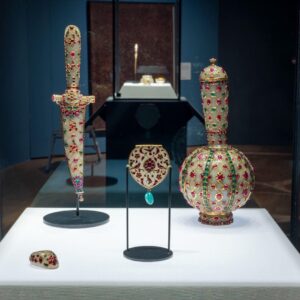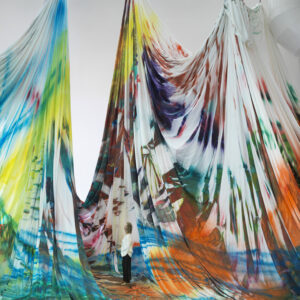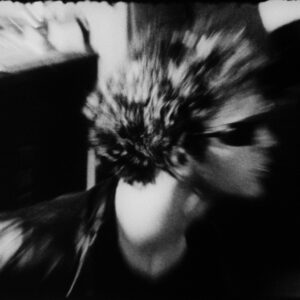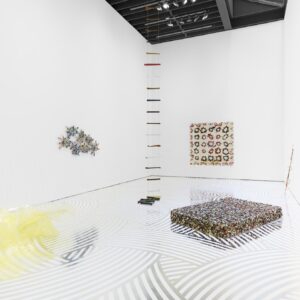
Caroline Absher is a Brooklyn-based painter whose work explores tenderness, serenity, and emotional resonance through vibrant color and intuitive composition. Her large-scale oil paintings offer immersive experiences, characterized by an energetic and expressive color palette that evokes both the ethereal and the natural world. Absher’s approach to painting is deeply personal yet universally relatable, merging abstraction with figuration to create evocative moments that feel simultaneously intimate and expansive.
Absher’s color choices are often inspired by a wide range of influences—from the concept of auras and the surreal to her formative years spent in South Carolina. Surrounded by the raw beauty of unspoiled nature, she developed a profound connection to the world around her, a relationship that continues to shape her work. The colors she uses are not merely aesthetic choices but are imbued with emotional and symbolic significance. Whether working in soft tones or bold, saturated hues, Absher creates a visual language that speaks to both the subconscious and the senses.
A hallmark of Absher’s process is her emphasis on intuition. She begins each painting by layering abstract lines and washes of color, allowing the composition to unfold organically. As the painting develops, Absher steps back to assess the emerging shapes and figures, often discovering human and animal forms and faces arising from the chaotic underpainting. These figures, which can be seen as extensions of the artist herself or as memories of loved ones, strangers, or fleeting encounters, take on a larger-than-life quality. By enlarging these figures, Absher imbues them with a sense of presence and importance, elevating the ordinary to the extraordinary.
Absher’s work is marked by a continual exploration of identity and connection. Her figures often include depictions of her own face and body, but they also represent those of people she has known intimately, as well as those she has encountered only briefly. The resulting imagery captures both the familiarity and mystery of human interaction, creating a sense of shared humanity through the lens of the personal and the ephemeral.
After earning both a BA in Art History and Painting from Pratt Institute in Brooklyn, Absher has established herself as a prominent figure in contemporary painting. Her work has been exhibited extensively in New York City at venues such as Fredericks & Freiser Gallery and The Journal Gallery. Internationally, her exhibitions include V1 Gallery, Copenhagen; Eighteen Gallery, Copenhagen; Loyal Gallery, Stockholm; LBF Contemporary, London; Bode Gallery, Berlin; Green Family Art Foundation, Texas; Shrine Gallery, Los Angeles; among others. Absher has also participated in artist residencies such as the Macedonia Institute, New York, further expanding the scope and depth of her artistic practice. Abshers work has been acquired by the Portland Museum of Art.
In her work, Absher continues to explore the delicate balance between abstraction and representation, color and emotion, presence and absence. Her paintings invite viewers into a space of reflection, where the boundaries between the seen and the unseen blur, and where the quiet beauty of human connection is rendered in vivid, unforgettable hues.
Absher will be exhibiting at the Journal Gallery in Los Angeles in April 2025.

Oil paint plays a significant role in your artistic practice. In what ways does the materiality of oil paint—its viscosity, texture, and ability to layer—inform your exploration of both emotional depth and the relationship between abstraction and figuration?
Oil paint is endless because it can’t be fully mastered. If you ask any oil painter how it’s going, there will be new drama. The learning curve just keeps going. Painting is more than something I love. The process of constant searching and experimentation forces me to be absolutely present, the kind where hours feel like minutes. It’s a powerful healing state. The initial experiment determines the rest, combining with the logic of planning, mapping, and research.

How do you perceive its properties as distinct from other media, such as acrylic or watercolor, in terms of the conceptual and sensory dimensions they enable in your work?
You can erase with oil, even after a day’s work. It’s much easier to control the opacity as well.
Your color palette carries a palpable emotional resonance in your work. Could you elaborate on the decision-making process behind your color choices?
I’ll be learning color forever. I intentionally keep my plan for the palette as vague as possible, beginning with a broad idea and narrowing with time. Recently I’ve been really into earth tones and grays because they make everything they touch brighter.
Your work seems to capture emotional states such as hope, tenderness, and fulfillment—qualities often associated with impermanence. How do you represent such transient emotions visually?
Right now I am looking for the balance between there / not there. It’s important for me not to make things too literal.


Does the inherent fleeting nature of these themes influence the formal qualities of your work, such as composition or color?
Yes, its all connected.

Many of your works seem to invoke a dreamlike, surreal quality, particularly in the way abstraction and figuration coexist, Green Eyes is one of my favorite and recent examples. How do you conceptualize the relationship between nature, dreams, and reality in your practice?
The wilderness feels like a dream. Camping and climbing and being outside is where I am happiest. It’s shocking to go back to civilization even after a couple nights of camping. I grew up in the Appalachian Mountains, surrounded by forest. The feeling of being deep in nature is always with me. There is a distinct presence that can be felt in every living thing.
To what extent do you see these realms as interwoven, or is there an intentional blurring of boundaries between them in your work?
They are interwoven.
Your paintings often juxtapose themes of presence and absence, intimacy and distance. How do you engage with these dualities in your work, and what do they signify both on a personal level and within a broader cultural or existential context?
I embrace being contradictory. Humans are messy, but intimacy is not possible without conflict and repair. Learning how to sit with discomfort instead of throwing the whole thing away.

The concept of scale plays a significant role in your work, particularly in the way you render your figures which vary in scale. Could you discuss how you approach the theme of scale?
I first understood the function and impact of a human – sized artwork the first time I saw one of Richard Serra’s 6ft cubes in high school. I would make more small scale work if it weren’t for the enjoyment of feeling like I’m in the painting. As far as scale within the compositions, it’s important to second guess myself. Not letting things come TOO naturally is something to pay attention to, all related to balance. Anything compositionally formulaic would hinder the work because it would be boring for me. Lately, I have been embedding very small drawing elements.
Is it a gradual shift in your work, or was there a pivotal moment when you consciously decided to magnify or minimize your subjects?
Gradual.

Many of your pieces suggest a meditation on time—whether through the rendering of memory, fleeting moments, or the perception of change. How do you understand the relationship between art and memory?
Our perception of the past is tied to memory – so by creating paintings, writing things down, etc, we are fundamentally altering our own perception of events through time. Paintings are sent forward into the future as messages. I think if the intention is there, a message will reach its destination eventually, but there’s no way of knowing.
Does art function as a means of preserving transient experiences, or is it more concerned with the act of remembering itself, with all the nuances and distortions that come with it?
Both.
When you consider the viewer’s experience of your work, what emotional or intellectual response do you hope to evoke?
I know my favorite thing about looking at a work of art is when it looks like the artist was just absolutely obsessed with making that thing, even if it took 5 seconds, I can tell. It’s inspiring. So if that were my criteria, all I have to do is my best.

Is there a particular journey or transformation you envision for the viewer, one that mirrors or challenges their own experiences and perceptions?
If I could ask my work to say something specific, I’d ask it to say, “you aren’t alone”.
In today’s rapidly changing cultural landscape, what do you believe art’s role is in society?
As long as there have been humans, there have been artists. Creative minds are going to continue doing the most because it’s all problem solving. If certain industries eventually collapse, artists will still exist. They’re how we persevere. Gardening, cooking, building, education, music, dance, generation of any kind. The art that will one day define this moment is most likely already separate from the art market.

What kind of impact do you aspire for your work to have—both on individual viewers and within the broader cultural or societal discourse?
Respect Nature, be gentle, follow your own compass.
To learn more about Caroline Absher, follow her on Instagram at @carolineleanor and visit her website at carolineeleanor.com




